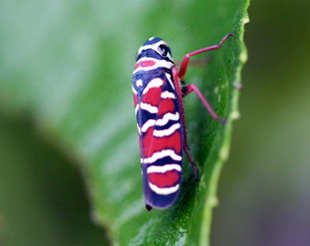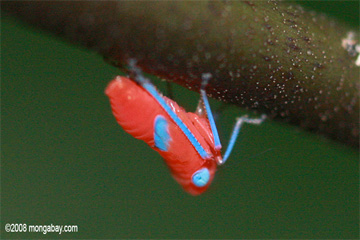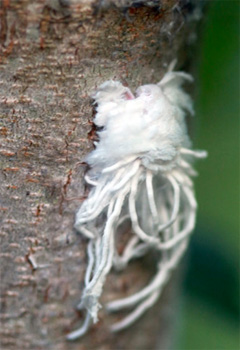|
|
Scientists have long recognized ‘coextinctions’ as a major concern when it comes to the current mass extinction crisis. Despite such recognition, however, the role of coextinctions remains largely mysterious and little-studied. A new paper attempts to address this by settling what is known (and unknown) about the phenomenon of coextinctions and where research needs to go next.
Coextinction is the loss of a species due to the fact that the species it was dependent on has also vanished. For example, if a plant species has only one pollinator and that pollinator goes extinct then the plant is doomed as well, or if a louse depends on a particular mammal species which disappears then the louse will also vanish. This process is also known as secondary extinctions, chains of extinctions, extinction cascades, or trophic cascades. While it sounds simple, the paper published in the Proceedings of the Royal Society B points out that in reality the theory has proven anything but.
Hidden extinctions?
Several studies have shown that coextinctions should be widespread. Parasites and mutualists, after all, are hardly lacking in the natural world and it makes sense that when one species vanishes its dependents will follow. Coextinctions are thought to be so important that scientist JM Diamond has placed it with habitat loss, overkill, and species invasion as one of the four leading drivers of extinction (the current paper adds a fifth: climate change). Yet as prevalent as coextinctions are thought to be, scientists have recorded few actual occurrences.
“Although tens or even hundreds of thousands of coextinctions…are predicted on the basis of coextinction models, few recent coextinctions have been empirically documented,” the paper’s authors write.
 Plant parasite in Costa Rica |
The authors point out a number of possible reasons for this. The first is that coextinctions may be occurring at the levels predicted—one model estimated 56 coextinctions could occur from just five extinctions of North American mammals—but these coextinctions have gone largely unnoticed. This is perhaps unsurprising when considering that most coextinctions involve small and often overlooked species such as aphids, ticks, pollinating insects, lice, bacteria, viruses, fleas, and many others.
“For a long time, most of conservation has focused on vertebrates, whether because they are, in and of themselves, worthy of conservation, or because they are umbrellas for the conservation of other species,” explains Dr. Rob Dunn, lead author of the paper. “Save the panda and you also save the panda’s habitat and the other species that depend on it, or so goes the logic. We like warm fuzzy things with big eyes. They also so happen to be much easier to study, at least in some respects. We can make a realistic estimate of how many pandas there are on Earth. Studying coextinctions often depends upon studying organisms that are less warm and fuzzy than pandas (not quite cold and slimy, but you get the picture). Those species are, in turn, also usually small. And so they are less appealing from a human aesthetic perspective and more difficult to study.”
These two factors—less appealing (equaling less support from the general public) and more difficult to study (so fewer scientists working with them) —would be the reasons why species disappearing due to coextinctions have gone unnoticed for so long. However, the authors posit another hypothesis to explain the disparity between predicted models and recorded observations.
Or tough survivors?
The other possibility is that coextinctions are not occurring at the rate predicted through models. Many parasites and mutualists are thought to be wholly dependent on a single species; however, it is possible that this assumption is wrong. As the authors write, “more study often, but not always, reveals that parasites are more generalist than assumed.” So, if parasites are spread wider than assumed, even across closely related species, then coextinction would occur less often.
However, the plot thickens when one considers recent genetic analysis. “Well-sampled generalist ‘species’ may actually consist of a number of hard-to-distinguish specialists,” the authors point out. If it is determined that the generalist is actually a number of specialist species, not only would this affect the models predicting coextinction, but also estimations of species numbers worldwide. As is common in current biology, genetic studies of species complicate every previous assumption.
 Insect in Suriname |
The researchers point to a final possibility to explain why observed coextinctions have yet to match-up with predictions: perhaps, parasites and mutualists have a greater capacity to jump ship than expected. In other words, these tiny species may overcome the demise of the animal or plant on which they depend by eventually finding another suitable host. They are tough survivors.
“Such host shifts are another consequence of coextinction and coendangerement dynamics. In fact, the overall math is simple. If we predict on the basis of what we know about which hosts and parasites…that tens or hundreds of thousands of parasites might go extinct, then either we have an extinction problem OR we have a host switching problem,” Dunn explains.
This capacity to switch hosts depends on a species’ ability to adapt rapidly enough to successfully survive on its newly chosen host.
“On the one hand, growing numbers of studies find evidence of rapid evolution of the ability to survive and reproduce on new hosts…yet, in order to understand the significance of evolutionary responses to estimates of coextinction rates, one needs to know how often such events occur,” write the authors. Such conclusions bring more questions than answers.
To uncover the answers and discover which theory proves correct, Dunn sees a need for more data and research.
“Careful studies of museum skins could be very useful,” Dunn says. “Rare primates, for example, tend to have fewer parasite species, but it is unclear whether that is due to the extinction of their parasites or because they never, thanks to some historical rarity, had as many. Study of the skins of those primates would be very useful in distinguishing these possibilities. We also need more sophisticated models of extinction dynamics, but that are modeled based on realistic systems.”
Why conserve parasites?
Whichever explanation turn out to be correct—is coextinction rare or common—the authors argue that conservation of parasites, mites, ticks, aphids, bacteria, viruses, fleas, and lice is important.
“Loss of dependent species in general, be they parasites such as lice or butterflies, or mutualists such as honey bees, bears all of the same negative consequences as the loss of any species. There are lost opportunities,” Dunn says. “Who knows what medicinal value an extinct flea might have had? There are lost ecological services, such as those provided by dung beetles, honey bees, or even, in many contexts, parasites. In addition, there is the lost potential for future diversification.”
In addition, perhaps paradoxically, extinction of specialist parasites may harm—or doom—the charismatic species conservationists have spent time and funds to save.
 Insect in Sumatra, Indonesia |
Dunn explains: “If a specialist parasite goes extinct when its host becomes rare, it may favor a generalist parasite instead. For example, the California Condor was ‘deloused’ when it was brought into captivity. That delousing appears to have led to the extinction of at least one and potentially several specialist parasites. A similar case occurred with the black-footed ferret. Yet, in both cases I guarantee that the reintroduced individuals still have parasites, we have just rid them of specialists and replaced (the specialists) with generalists which may have much greater negative effects (because the hosts are not used to the new parasites).”
The extinction of host animals could also greatly affect human health and the domesticated animals on which we depend.
If parasites don’t go extinct with their hosts “they will be looking for new hosts,” says Dunn. “Given that most vertebrates on Earth are humans and our domesticates, those hosts will often be us. Already humans have more parasites than any other vertebrate yet studied. In fact, we appear to have more parasites dependent on us than there are parasites dependent on all the North American carnivores.”
Dunn is able to connect this to patterns already seen in diseases spreading to humans.
“It is noteworthy that many emergent diseases have as original hosts vertebrates that are relatively rare,” he says. “In addition, we know that those regions with many emergent zoonotic diseases are the same regions with many rare vertebrates, suggesting that we may already be experiencing some of the health consequences of coendangerement, if not coextinction.”
Conclusion
One fact that hold no mystery is that parasites and mutualists are entirely unrepresented in conservation efforts. The authors point to a 2006 study by J.I. Thacker which identified 24 aphids that are threatened with extinction due to the trees they depend on also being threatened, a status listed as coendangerement. None of these aphids, however, are listed in the International Union for the Conservation’s Red List, the most reputable source on species status. In fact, according to the paper only one species in the entire Red List is listed due to being coendangered, and that is the pygmy hog-sucking louse Haematopinus oliveri, which depends on the critically-endangered pygmy hog for survival.
The authors call this “an indication of more fundamental problems with the listing of small species and insects in particular”.
Of course, even beginning to address the threat of coextinction raises novel problems.
“If, as we suggest, many coextinctions are occurring, it is hard to know just how to act in order to better conserve those dependent species,” Dunn says. “Should we manage and conserve rare parasites and mutualists in zoos and captive breeding programs? It is a difficult question. If there are, as seems possible, thousands of rare and endangered parasite species in North America (for example), do they then all need to get listed as Endangered Species? These are hard questions we haven’t really grappled with.”
Despite these issues and the need for additional research, the importance of conserving all biodiversity, including parasites and mutualists, is clear to Dunn.
“The only value one might ascribe to a panda in terms of conservation, that a panda mite would not also possess, is charisma and aesthetic appeal,” he explains. “We can, as a society, decide that aesthetic appeal should be the most important determinant of which species are conserved, but we ought to make that decision (one I personally think is unwise) consciously, if it represents our collective decision.”
Robert R. Dunn, Nyeema C. Harris, Robert K. Colwell, Lian Pin Koh and Navjot S. Sodhi. The sixth mass coextinction: are most endangered species parasites and mutualists?. Proceedings of the Royal Society B. May 27, 2009.
Related articles
Symposium tackles big question: how many species will survive our generation
(01/16/2009) Nine scientists dusted off their crystal balls Monday at the National Museum of Natural History in Washington DC, weighing in on the future of the world’s tropical forest. Despite the most up-to-date statistics, prognosis for the future of tropical forests varied widely. In the last few years a schism has occurred among biologists regarding the future of the tropics. No tropical scientist denies that rainforests and the species which inhabit them face unprecedented threats; neither do they argue that some of these forested regions and species will likely not survive the next fifty years. What has sparked debate, sometimes heated, is how bad will is it really? When the dust settles, what percentage of species will survive and how much forest will remain?
7 steps to solve the global biodiversity crisis
(08/11/2008) Many biologists believe Earth is entering a sixth mass extinction event, one that has is the direct of human activities, including over-exploitation, habitat destruction and introduction of alien species and pathogens. Climate change — largely driven by anthropogenic forces — is expected to soon increase pressure on Earth’s biodiversity. With population and per-capita consumption expected to grow significantly by the mid 21st century, there seems little hope that species loss can be slowed. Nevertheless, writing in the journal PNAS, Stanford biologists Paul R. Ehrlich and Robert M. Pringle suggest seven steps to help improve the outlook for the multitude of species that share our planet.
New math shows that threat of extinction is underestimated globally
(07/07/2008) For some species the odds of survival may have changed. According to a new study current extinction models have underestimated the threat of extinction by not factoring in differences among individuals in a population. Such differences include the ratio of males to females, size and health of animals, and individual behvaioral patterns. A study conducted by Brett Melbourne of University of Colorado, Boulder and Alan Hastings of the University of California, Davis, shows that the new model speeds the extinction time for some species up to 100 times what was previously thought.